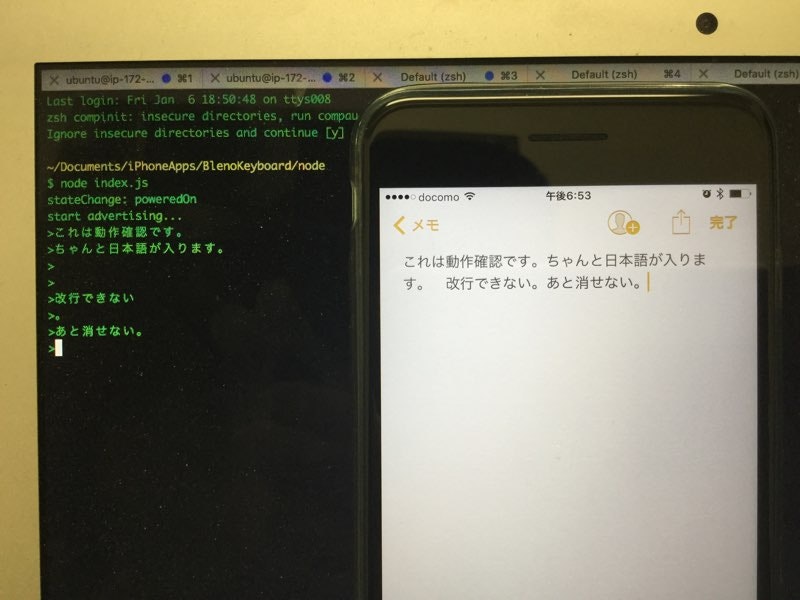オリィ研究所(http://orylab.com/) の 椎葉です。
最近blenoを使う機会があったので遊んでみます。
bleno
Mac、Win、LinuxのマルチプラットフォームでBluetoothペリフェラル(デバイス側)の実装が行えるNode.jsのライブラリです。
MacではXCodeが、Winでは対応したBluetoothアダプタが必要と、実行できる環境が限られるので通常のElectronアプリケーションなんかではあまり実用的ではないものの、組み込み用途ではちゃんと機能します。
手元で動かすだけでも、Bluetoothでデバイスを横断しているとなんか楽しいです。
今回は1Keyboard(http://www.eyalw.com/1keyboard) のように、Mac側のキーボード入力で動作するiOSのカスタムキーボードを作ってみたいと思います。
bleno側準備
以下、OS Xでのみ実行を確認しています。
Node.jsプロジェクトを用意して、プロジェクトルートで
npm install bleno --save
します。これでblenoの準備は完了です。ビルドも済みます。
blenoクラス
libにbleno.coffeeとかを作ってblenoクラスを作ります。
bleno = null
readline = require 'readline'
class Bleno
readLine: null
stop: false
constructor: ()->
try
# blenoはrequireが例外を吐く
bleno = require 'bleno'
@init()
catch error
bleno = null
init: ()->
name = 'BlenoKeyboard'
serviceUuids = [ 'fff0' ]
# Serviceの定義
primaryService = new bleno.PrimaryService
uuid: 'fff0'
characteristics: [
# Characteristicの定義
new bleno.Characteristic
uuid: 'fff1'
properties: [
'notify'
]
# Notifyに登録された時
onSubscribe: (maxValueSize, updateValueCallback)=>
@stop = false
@startInput updateValueCallback
# Notifyが解除された時
onUnsubscribe: ()=>
@stopInput()
]
# bluetoothデバイスの状態変化イベント
bleno.on 'stateChange', (state) ->
console.log 'stateChange: ' + state
if state == 'poweredOn'
bleno.startAdvertising name, serviceUuids, (error) ->
if error
console.error error
return
else
# startする
bleno.stopAdvertising()
return
# advertising startイベント
bleno.on 'advertisingStart', (error) ->
if !error
console.log 'start advertising...'
# Service設置
bleno.setServices [ primaryService ]
else
console.error error
return
# コマンドライン入力を受け付けて送信する
startInput: (valueCallback)->
@readLine = readline.createInterface
input: process.stdin
output: process.stdout
@readLine.question ">", (answer)=>
if answer isnt ""
data = Buffer.from answer, 'utf8'
# iOSデバイスへ送信!
valueCallback data
@readLine.close()
if @stop then return
@startInput valueCallback
# 入力を受け付けて送信する
stopInput: ()->
@stop = true
if @readLine
@readLine.close()
これをindex.jsから実行すればNode.js側の実装は完了です。
// 無いなら npm install coffee-script --save
require('coffee-script/register');
Bleno = require('./lib/bleno');
new Bleno();
試す
実行してみます。
node index.js
iOSデバイス側でうまく動作しているか確認します。
LightBlue Explorer( https://itunes.apple.com/us/app/lightblue-explorer-bluetooth/id557428110?mt=8 )をiOSデバイスにインストールして、Macや実行デバイスを探してみましょう。
見つかったら接続してnotificationsをサブスクライブします。Node.js側での入力が毎回送信されるか確認しましょう。
ここが動けばもう一息。
iOS側をSwiftで実装する
XCodeとSwift 3に移動して、iOSアプリ側を実装します。
一般的なカスタムキーボードに、CoreBluetoothを組み込んでNode.jsが実行されているデバイスと連携します。
deviceNameにLightBlueで見つかったデバイス名を入れます。自分のMacの名前になるはずです。
import UIKit
import CoreBluetooth
class KeyboardViewController: UIInputViewController, CBCentralManagerDelegate, CBPeripheralDelegate {
@IBOutlet var nextKeyboardButton: UIButton!
let deviceName = "Enter your Mac name"
var centralManager: CBCentralManager!
var peripheral: CBPeripheral!
var characteristics = [CBCharacteristic]()
override func updateViewConstraints() {
super.updateViewConstraints()
// Add custom view sizing constraints here
}
override func viewDidLoad() {
super.viewDidLoad()
self.centralManager = CBCentralManager(delegate: self, queue: nil)
// Perform custom UI setup here
self.nextKeyboardButton = UIButton(type: .system)
self.nextKeyboardButton.setTitle(NSLocalizedString("Next Keyboard", comment: "Title for 'Next Keyboard' button"), for: [])
self.nextKeyboardButton.sizeToFit()
self.nextKeyboardButton.translatesAutoresizingMaskIntoConstraints = false
self.nextKeyboardButton.addTarget(self, action: #selector(handleInputModeList(from:with:)), for: .allTouchEvents)
self.view.addSubview(self.nextKeyboardButton)
self.nextKeyboardButton.leftAnchor.constraint(equalTo: self.view.leftAnchor).isActive = true
self.nextKeyboardButton.bottomAnchor.constraint(equalTo: self.view.bottomAnchor).isActive = true
}
override func viewWillAppear(_ animated: Bool) {
super.viewWillAppear(animated)
if self.centralManager.state == CBManagerState.poweredOn {
self.centralManager.scanForPeripherals(withServices: nil, options: nil)
}
}
override func viewWillDisappear(_ animated: Bool) {
super.viewWillDisappear(animated)
if let centralManager = self.centralManager {
if centralManager.state == CBManagerState.poweredOn {
if let peripheral = self.peripheral {
if peripheral.state == CBPeripheralState.connected {
centralManager.cancelPeripheralConnection(peripheral)
}
}
}
}
}
override func didReceiveMemoryWarning() {
super.didReceiveMemoryWarning()
// Dispose of any resources that can be recreated
}
override func textWillChange(_ textInput: UITextInput?) {
// The app is about to change the document's contents. Perform any preparation here.
}
override func textDidChange(_ textInput: UITextInput?) {
// The app has just changed the document's contents, the document context has been updated.
}
// MARK: - bluetooth
func centralManagerDidUpdateState(_ central: CBCentralManager) {
print("ble state: \(central.state)")
if central.state == CBManagerState.poweredOn {
print("ble state is on")
self.centralManager.scanForPeripherals(withServices: nil, options: nil)
}
}
func centralManager(_ central: CBCentralManager,
didDiscoverPeripheral peripheral: CBPeripheral,
advertisementData: [String : AnyObject],
RSSI: NSNumber) {
print("ble peripheral: \(peripheral)")
if peripheral.name == self.deviceName {
if self.centralManager.state == CBManagerState.poweredOn {
self.centralManager.stopScan()
}
self.peripheral = peripheral
self.centralManager.connect(peripheral, options: nil)
print("connecting peripheral...")
}
}
func centralManager(_ central: CBCentralManager,
didConnect peripheral: CBPeripheral)
{
print("connected peripheral")
self.peripheral.delegate = self
self.peripheral.discoverServices(nil)
}
func peripheral(_ peripheral: CBPeripheral, didDiscoverServices error: NSError?) {
if let error = error {
print("error: \(error)")
return
}
if let services = peripheral.services {
if services.count > 0 {
for service in services {
if service.uuid.uuidString == "FFF0" {
self.peripheral.discoverCharacteristics(nil, for: service)
}
}
}
}
}
func peripheral(_ peripheral: CBPeripheral, didDiscoverCharacteristicsForService service: CBService, error: NSError?) {
if let error = error {
print("error: \(error)")
return
}
if let characteristics = service.characteristics {
print("Found \(characteristics.count) characteristics! : \(characteristics)")
self.characteristics = characteristics
self.startNotice()
}
}
func startNotice() {
for characteristic in self.characteristics {
if characteristic.uuid.uuidString == "FFF1" {
print("start notice")
self.peripheral.setNotifyValue(true, for: characteristic)
}
}
}
func stopNotice() {
for characteristic in self.characteristics {
if characteristic.uuid.uuidString == "FFF1" {
print("stop notice")
self.peripheral.setNotifyValue(false, for: characteristic)
}
}
}
func peripheral(_ peripheral: CBPeripheral, didUpdateValueForCharacteristic characteristic: CBCharacteristic, error: NSError?)
{
if let error = error {
print("error: \(error)")
return
}
print("get data, characteristic UUID: \(characteristic.uuid), value: \(characteristic.value)")
if let data = characteristic.value {
let inputText = String(data: data, encoding: .utf8)
self.textDocumentProxy.insertText(inputText!)
}
}
// MARK: - util
func showAlertByMessage(message: String) {
let alert: UIAlertController = UIAlertController(title: nil, message: message, preferredStyle: .alert)
let okAction: UIAlertAction = UIAlertAction(title: "はい", style: .default) { action -> Void in
}
alert.addAction(okAction)
self.present(alert, animated: true, completion: nil)
}
}
Keyboardターゲットのinfo.plistでRequestsOpenAccessをYESにしたら準備完了です。
blenoとあわせて試す
Swift製のアプリをXCodeからデバイスに入れます。
キーボードの登録とフルアクセス許可を忘れないように行いましょう。
ちゃんと動く!
長文とかURLとかの入力がはかどりそう、と思いきや、このままでは改行できないしBSもないので使い物になりません。
また次回にでも調整を加えようかと思います。
